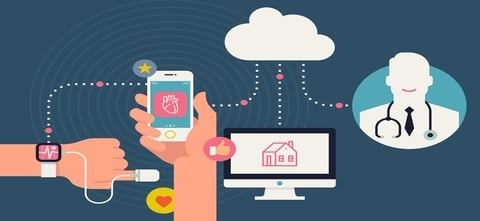The "Things" in the Internet of Things (IoT)
The "Things" in the Internet of Things (IoT)
- Last Updated: December 2, 2024
Michael Wedd
- Last Updated: December 2, 2024



You may be familiar with how the internet works. And you've probably heard of how the "Internet of Things," or "IoT," is igniting the next industrial revolution. But you may be wondering, what do "things" represent in the Internet of Things? What makes these "things" different from, say, a computer or a smartphone that connects to the internet?
What Do The "Things" Represent in The Internet of Things?
Here's your answer: the "things" in the Internet of Things can be anything from farming equipment (a tractor, an irrigation system, a drone) to the thermostat on your wall, to your "connected car," to a freight container with a connected temperature sensor within it that sends data to a logistics coordinator.
The Value of Connected "Things" in Healthcare, Logistics and Agriculture
IoT for Healthcare: Our Bodies as "Things" connected to the Internet
"Things" in IoT can also be "wearables" that serve medical purposes. Devices that monitor your bodily functions and systems daily and make that data available to your doctors can function as an early warning system for health issues and a way for you to keep yourself accountable to your health goals.

Image Credit: Sensors Magazine
As Lalit Panda writes in What Is the Internet of Medical Things (IoMT)?, "With streaming information, preventive care can reduce hospitalization and reduce the cost of acute care significantly." However, both Panda and Kristina Podnar, in her article, warn of the serious risk of accidents and abuse that come with connecting our bodies to the internet. In the case of healthcare, a "thing" in the Internet of Things would be our very bodies.
What do 'things
IoT for Logistics: Packages and Containers As "Things" Connected to the Internet
Logistics and Supply Chain Management are all about moving things from point A to point B. Keeping tracking of those things in an ideal world isn't terribly difficult. You send shipment X from warehouse Y to customer Z, and you know everything will work out, right? Wrong! The world is dynamic, shifting, and chaotic. Things go wrong. Everything from weather disasters to piracy can affect global shipping lanes and cause delays and financial losses. And sometimes it's merely naturally built-in inefficiencies that cause losses and delays.
In 2018, in the UK alone, inefficiencies in the supply chain resulted in losses of about $2B, due to what one study called "a game of Chinese whispers" as packages zigzag around the world. Ericsson recently argued in an article on IoT For All that "supply chain participants are connected—just not to each other or not at the right time."
That's where the Internet of Things comes in. For Logistics and Supply Chain Applications, "things" in IoT cargo containers, trucks, port utility equipment and, most importantly, data pipelines and digital ledgers for tracking shipments reliably as they traverse the world and change hands.
<!-- wp:heading {" />
IoT for Agriculture: "Things" as Tractors, Soil Sensors and Irrigation Systems
From irrigation to crop rotation to fertilization to genetic modification, we've been changing the way we grow and harvest food for thousands of years. Farms have grown from small, family- or community-managed organizations to vast enterprises that sprawl across thousands or even millions of acres. As populations exploded throughout the 20th century, farmers have turned to technology to meet growing demands. The 21st century is no different; farmers continue to find innovative ways to meet food supply needs in an increasingly interdependent and environmentally unstable world.
IoT is enabling a whole range of agricultural innovations. As SciForce writes on IoT For All, farmers are starting to use IoT, drones and AI to "increase the quantity and quality of products while optimizing the human labor required by production."
The photo below shows a soil monitoring solution called "CropX" being used to help farmers better understand which fields need watering when and how soil conditions change over time—all remotely and at massive scale.
<!-- wp:paragraph --> <p>In this example, CropX represents a " />
The Best Way to Predict the Future Is to Build It
In the now distant past, every "thing" was disconnected. Then the telephone came around and enabled us to connect people and spaces across hundreds and then thousands of miles. Then we started sending not only our voices but other kinds of information across the wire, like documents, images, videos, etc. But we couldn't stop by connecting only things like computers and smartphones to the internet. Why end there? Now we're focused on connecting the myriad other objects and spaces we use for everyday life and business processes to the internet so that we can extract insights about the world around us and interact with our "things" remotely and at massive scale.
The internet changed the world while only really connecting personal and enterprise computers as well as smartphones. Imagine what's possible when you take the many other "things" with which we interact everyday and connect them to the internet?
Well, you don't really have to imagine it. The Internet of Things is fast becoming our new reality.
The Most Comprehensive IoT Newsletter for Enterprises
Showcasing the highest-quality content, resources, news, and insights from the world of the Internet of Things. Subscribe to remain informed and up-to-date.
New Podcast Episode

The State of Smart Buildings
Related Articles




